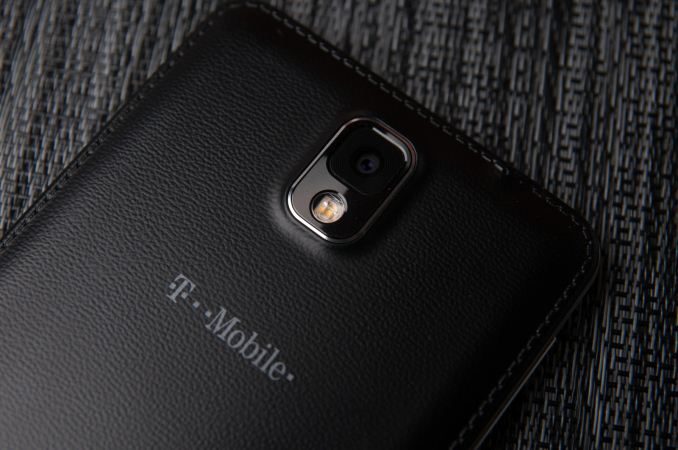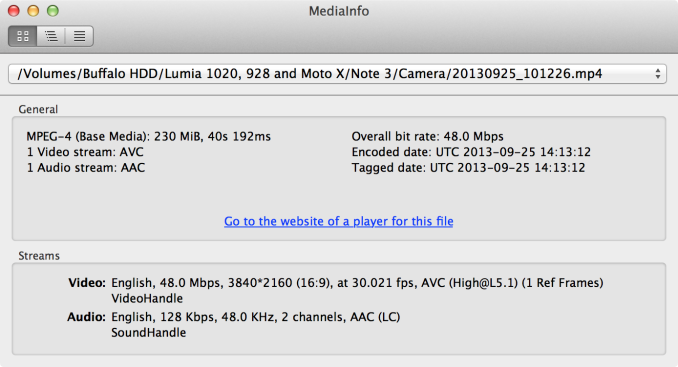Samsung Galaxy Note 3 Review
by Brian Klug on October 1, 2013 9:00 AM EST- Posted in
- Smartphones
- Samsung
- Mobile
- Android 4.3
- galaxy note 3
Camera
The cadence for camera on the Note platform has been pretty steady so far, it just inherits the camera module from the Galaxy S that came before it. In the case of the Note 3, that means the same module from Galaxy S 4, which is as far as I can tell what happened here. There’s an IMX135 sensor inside the Note 3, same as what shipped in GT-I9500, from Sony’s Exmor RS line. Specifically that means the Note 3 includes a 13 MP CMOS on the back with 1.12µm size pixels and a 1/3.06" optical format. Focal length changes slightly from 4.2 to 4.1 mm, but I’m not sure if this is just a rounding error, I suspect the same optical system is shared between the two, this works out to 31mm of focal length if you’re thinking 35mm equivalent numbers.
On the front is a 2 MP Samsung S5K6B2 CMOS with 1.34µm and 1/6" format. This is also shared with Galaxy S 4, which isn’t too surprising. So we have the same imaging on the back and the front as that flagship, with just different ISP in front of it with 8974.
Stills
For image quality we turn to the normal set of tests which I seem to always be adding to. Image quality bench locations taken at our usual set of locations, 3, 4, 5, 6, and 7 with the Note 3. In addition lights on and lights off in the lightbox, and the usual set of test targets.
Gallery: Smartphone Camera Bench
The Note 3 looks good outside and obviously reminds me exactly of the Galaxy S 4 when it comes to imaging performance. I never really had issues with SGS4 outside or in well lit scenarios, the Note 3 ends up being just about the same. I can’t say there’s really any surprises when it comes to still images out of the device, although the Note 3 absolutely struggles with white balance in the lightbox for some reason, which is odd considering Galaxy S 4 definitely didn’t have similar problems. Anyhow if you liked SGS4 imaging performance, Note 3 is definitely the same, it doesn’t really change the formula in low light however against the competition that now has OIS and bigger pixels, but I won’t belabor that point again.
Video
On the video side of the Note 3 we have an interesting new addition, 4k30 (or UHD) video record support, alongside both 1080p60 and 720p120. Higher framerate video has been an increasingly common thing lately, and the Note 3 supports this with the new video encode and decode capabilities of the 8974 SoC (Exynos 5420 doesn’t get any UHD video record features).
In the video recording UI you can select between the above video resolutions, at a framerate of 30 FPS. To get to 1080p60 you have to go under a different menu and select smooth motion, and 720p120 is under slow motion.
4k30 video gets recorded at 48 Mbps H.264 high profile with 1 reference frame, which will eat up space quickly but obviously blows things away with that much resolution, and 8974 doesn’t drop frames either. The 1080p60 video comes in at 28 Mbps H.264 high profile and also doesn’t seem to have any dropped frames. Audio in both cases is 128 kbps 48 kHz stereo AAC.
I uploaded two UHD samples to YouTube since it’s already 4K aware, if you select original quality from the switcher drop down. I don’t have a 4K display to view these on, but oversampled on the high resolution panels I do have it looks amazing. The 1080p60 content also looks great, although you’ll have to grab that one and view it on your own since YouTube (and really nowhere online I’m aware of) will show you 60p video at native framerate. I shot UHDp30 and 1080p30 videos in Times Square in NYC which you can grab, and UHDp30 and 1080p60 videos at the bench location which you can also grab if you want to look at that buttery smooth 60 FPS video.
I’m really impressed with video quality coming out of the Note 3, obviously having smartphones coming with UHD onboard is a big treat, and we now have smartphones beating other bigger standalone cameras to that punch.






















































302 Comments
View All Comments
doobydoo - Saturday, October 19, 2013 - link
'The chipset IS in fact performing as the benchmark indicates'No, it isn't. The chipset CAN'T reach the same speeds for any non-benchmark application, for reasons such as battery life and heat.
Your argument that bickering about performance is redundant is also stupid, because if it was, Samsung wouldn't feel the need to cheat them.
esterhasz - Wednesday, October 2, 2013 - link
I would be much in favor of standardized qualitative testing. Have a set five people panel use the phone for a day in their normal workflow and use a questionnaire for performance rating. Sure it's subjective, but users are subjects last time I looked.Demigod79 - Thursday, October 3, 2013 - link
Although I too would like to a cheat vs non-cheat result in benchmarks (perhaps mark out cheat results in a different color or something), Anand did state clearly that this was cheating. There was no glossing over this fact, he laid it out explicitly and said that he wanted this practice to stop (for all OEMs that do it).He also mentioned that it's unlikely that OEMs will stop doing this. It's easy for the OEMs to do and makes their products look better (and frankly, it's only technical geeks who care about things like this, and we only represent a tiny segment of smartphone buyers). If it sells more products, then they will do it (although I find it about as frivolous as the Nvidia and then-ATI battle to have the fastest GPU, simply for the sake of wearing the performance crown for a couple of months).
That being said though, this is benchmarks we're talking about here. Benchmarks do not represent real-world usage, and never have. All you have to do is look at 3DMark, which was criticized for some time as being too artificial (CPU speeds hardly mattered, whereas in real life CPU speed matters greatly). Benchmarks are, by nature, highly artificial tests meant to measure performance in a specific area. Although you can complain that cheating in benchmarks give a false impression of performance compared to other devices, you cannot say that such cheating misrepresents real-world usage since it doesn't represent real-world usage in the first place.
DanNeely - Tuesday, October 1, 2013 - link
"The impact is likely small since most of these tests should drive CPU frequencies to their max state regardless (at least on the CPU side), but I'm going to make it a point to call out this behavior whenever I see it from now on."Unfortunately this isn't the case. By decompiling benchmarks and changing package names to disable the cheat function Ars Technica discovered that the GN3 is inflating benchmark scores by 20-50%. Most got a 20% boost; Linpack was an outlier at 50%.
http://arstechnica.com/gadgets/2013/10/galaxy-note...
Anand Lal Shimpi - Tuesday, October 1, 2013 - link
This is unfortunately something we've seen on a lot of devices, not just Samsung. Google Experience devices aren't affected, but we've seen it on the SGS4 and HTC One among others.Linpack isn't a very consistent test and it's too short to drive frequencies up consistently, which is why I'm guessing it's an outlier. The 20% end is higher than expected, it's entirely possible that Samsung is lifting a thermal limit as well as driving CPU frequencies up.
I don't like any of it and I do want to see companies stop doing it. I was hoping we would see an end to it with the Note 3 but it looks like that was wishful thinking.
Take care,
Anand
Wojciech - Tuesday, October 1, 2013 - link
Have you thought about doing an article about 'fixing' benchmark scores by other OEM's?If you're saying that HTC is doing the same with One then maybe LG is doing something similar and maybe even Sony.
Normal behavior by Google experience devices would explain often lower scores than customized devices running on the same hardware platform.
Don't you think that would be an interesting topic to examine?
Right now I fear that more and more OEM's are going to start doing the same thing and the whole 'benchmark to determine real life performance' will be completely lost.
xype - Wednesday, October 2, 2013 - link
You don't like any of it? But you still put up the graphs and numbers with an "Oh my."? People come here because AnandTech has a reputation of providing in-depth, honest reviews. Most people scan the text and go right to the graphs. Their takeaway will be a marketing lie that you didn't bother to correct because "A lot of companies do that."? Seriously?Spunjji - Tuesday, October 8, 2013 - link
If you skim the text and go to the graphs you will never, EVER get a representative review of anything. People come to Anandtech for analysis and they got that with this review. If they missed that then they might as well have gone to any of the other sites.doobydoo - Saturday, October 19, 2013 - link
Na, most people come to Anandtech because they know the graphics will have been performed in an objective and logical way. I would bet that the vast majority of readers don't read the text associated with such images.And that doesn't mean that they should go to other sites.
Squuiid - Tuesday, October 1, 2013 - link
"It's also interesting to note that the Galaxy Note 3 appears to outperform all other Snapdragon 800 smartphones we've tested thus far. There's a couple of potential explanations here."You missed an explanation: Samsung cheat.
From Ars:
"The two functions applied to this list seem to be "PACKAGES_FOR_BOOST_ALL_ADJUSTMENT" which is no doubt the CPU booster, and "PACKAGES_FOR_LCD_FRAME_RATE_ADJUSTMENT" which makes it sound like they are also changing the display frame rate."